Creating your own calendar in a bullet journal is one of the most rewarding and practical layouts you can master.
Whether you want a simple monthly overview, a creative spread, or a functional grid packed with features, drawing your own calendar gives you total control over your planning system.
This guide will walk you through the process, from basic tools to advanced tips, so you can confidently design calendars that are both beautiful and useful.
What you’ll learn from this blog:
Why Draw Your Own Calendar?
- Customization: Tailor the layout to your needs, whether you want more space for weekends, a sidebar for notes, or color-coded events. This is a core reason why many people look up how to make your own bullet journal and how to layout bullet journal.
- Creativity: Express your style with hand-drawn elements, doodles, banners, or themed decorations. If you’re interested in bullet journal doodles how to or how to draw banners for bullet journal, this is your opportunity.
- Functionality: Add trackers, habit logs, or goals directly into your calendar. Consider integrating how to make a mood tracker bullet journal, how to do a habit tractor in a bullet journal, and tv show tracker bullet journal.
- Mindfulness: The act of drawing and organizing your calendar can be relaxing and help you focus on your priorities. This is especially helpful for those learning how to keep yourself motivated to follow bullet journal.
Essential Supplies
Before you start, gather these basic supplies for your bullet journal setup:
- Bullet journal (dot grid, square, or lined) — see how to make a bullet journal on lined paper for alternatives.
- Pencil and eraser (for sketching)
- Ruler or straightedge (for crisp lines)
- Fineliners or pens (for inking)
- Colored markers or highlighters (for accents)
- Stickers, washi tape, stencils (optional, for embellishments) — how to use washi tape in bullet journal can add flair.
If you’re going digital, explore how to make a digital bullet journal, how to create a bullet journal in onenote, how to use bullet journal app, how to make a bullet journal on phone, how to make bullet journals on android, how to use trello as a bullet journal, or how to create a digital bullet journal with evernote.
Understanding Calendar Layouts
There are several popular calendar layouts in bullet journaling. Choose the one that fits your planning style:
- Monthly Grid Calendar: A classic layout with days of the week as columns and weeks as rows, forming a grid (7 columns x 5 or 6 rows). Perfect for those searching how to draw a calendar in a bullet journal or how to bullet journal for month.
- Vertical List Calendar: Days of the month listed vertically, often with a space beside each date for notes or events. This is the original “monthly log” style from the bullet journal method.
- Weekly Calendar: A spread that breaks down each week, often with more space per day for detailed planning. Try adding a mini calendar in the corner for quick reference.
- Yearly (Future Log) Calendar: A compact overview of the entire year, useful for long-term planning.
Step-by-Step: Drawing a Monthly Grid Calendar
Step 1: Decide on Your Spread
- Single page: Compact, best for minimal notes.
- Double page: More space, allows for larger boxes and extra features like notes or goals. Great for how to bullet journal in a planner.
Step 2: Calculate Your Grid
- Columns: 7 (one for each day of the week)
- Rows: 5 or 6 (to accommodate all days in the month)
- Box size: Use your journal’s grid to measure. For example, if your page is 38 dots wide, each column could be about 5 dots wide with a small margin.
Step 3: Sketch the Grid
- Lightly draw horizontal and vertical lines with a pencil and ruler.
- Leave space at the top for the month title and days of the week.
- If using a double-page spread, extend the grid across both pages for a larger calendar.
Step 4: Add Days of the Week
- Label each column at the top (e.g., Mon, Tue, Wed, etc.).
- Decide if your week starts on Sunday or Monday, based on your preference.
Step 5: Number the Days
- Start numbering from the first day of the month, placing numbers in the top corner of each box.
- If the month doesn’t start on the first column, leave the earlier boxes blank or shade them for decoration.
Step 6: Ink and Decorate
- Trace your pencil lines with a fineliner for a clean look.
- Add color, washi tape, stickers, or doodles to personalize your calendar. If you want to know how to decorate bullet journal or how to decorate your bullet journal cover, this is your chance.
- Use highlighters to color-code events or mark important dates.
Example: Drawing a Monthly Calendar (Double Page Spread)
| Step | Instructions |
|---|---|
| Grid | Draw a 7×5 (columns x rows) grid across two pages. |
| Title | Write the month at the top, centered or with decorative lettering. |
| Days | Label each column with the day of the week. |
| Numbers | Fill in the dates, starting with the correct weekday. |
| Features | Add a sidebar for notes, goals, or a habit tracker if desired. |
| Decorate | Use colors, doodles, or themed elements to make it unique. |
Alternative Calendar Layouts
Vertical List Monthly Log
1. Draw a vertical line down the page.
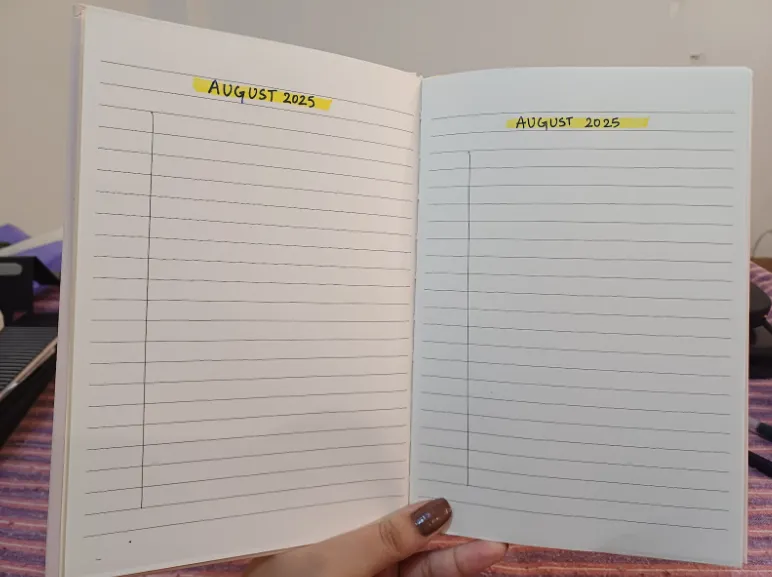
2. Write the dates of the month in a column.
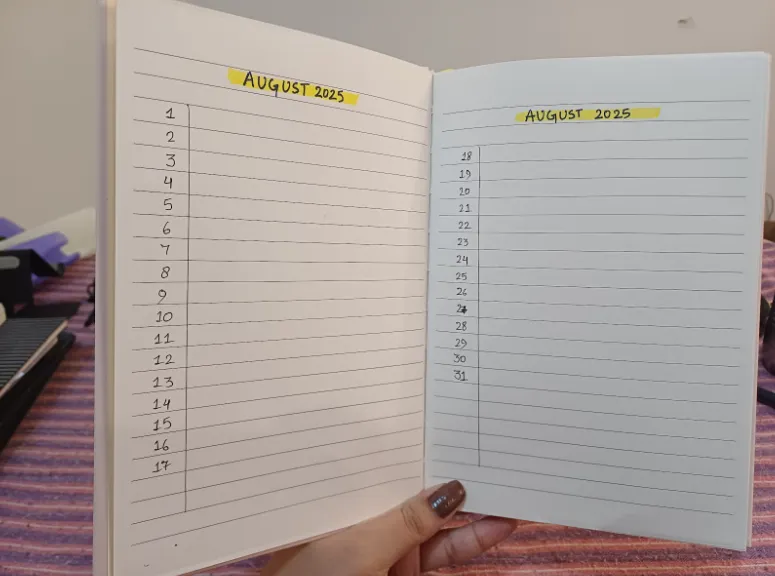
3. Next to each date, write the day of the week.
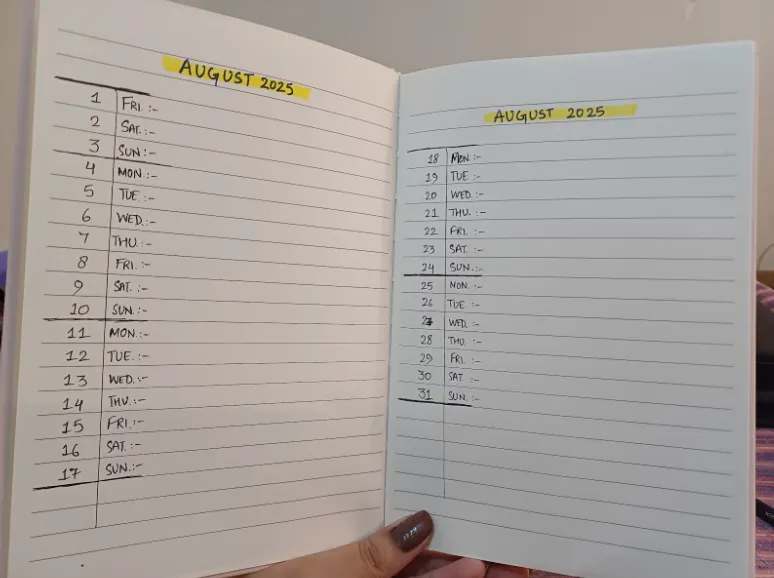
4. Use the space next to each date to jot down your most important events, tasks, or reminders. I haven’t filled mine in just yet—this calendar is a fresh start in my new notebook, created just to show you all how I set things up. Who knows what next month has in store!
5. DECORATE! Add embellishments like stickers in your bullet journal to make your calendar spread aesthetically pleasing! This is completely optional, don’t take any pressure for this.
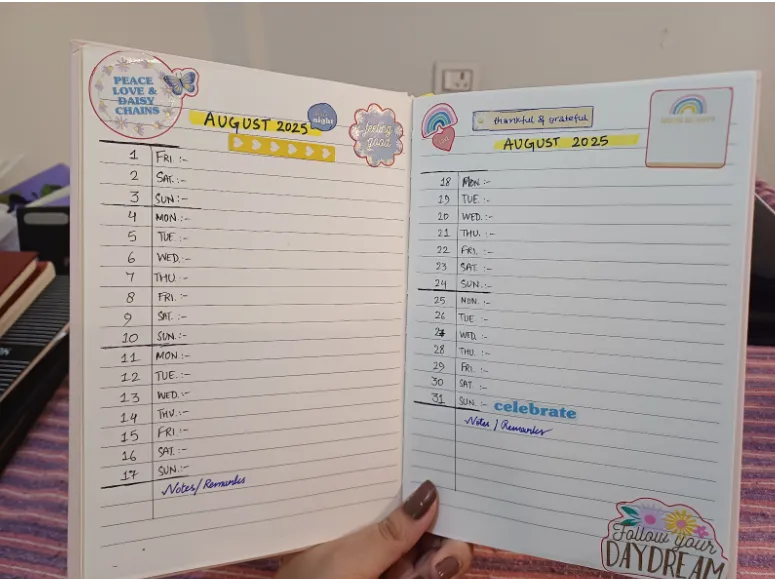
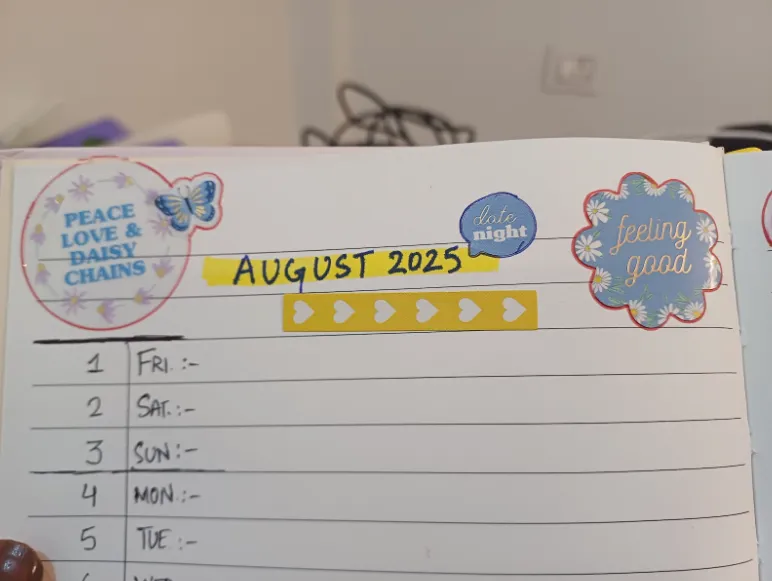
Mini Calendars for Weekly Spreads
1. In your weekly spread, draw a small calendar in the corner for quick reference.
2. Highlight the current week for context or tick the days of the week/month that have already passed.
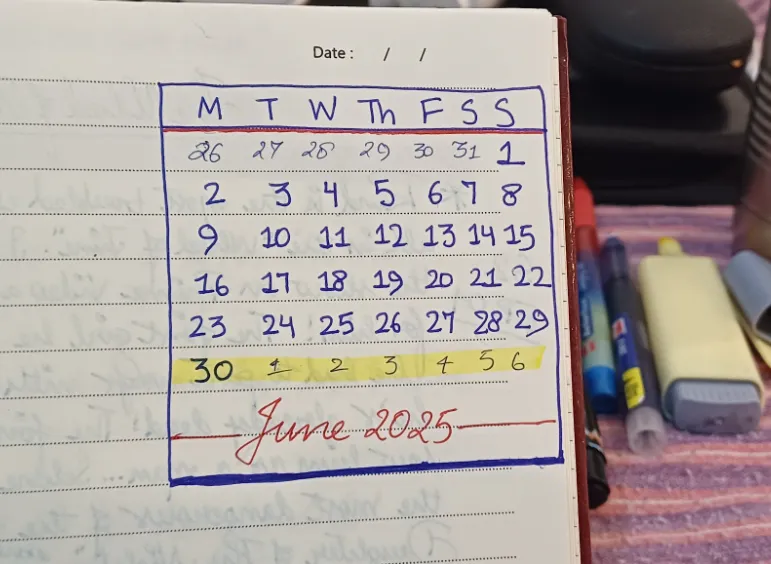
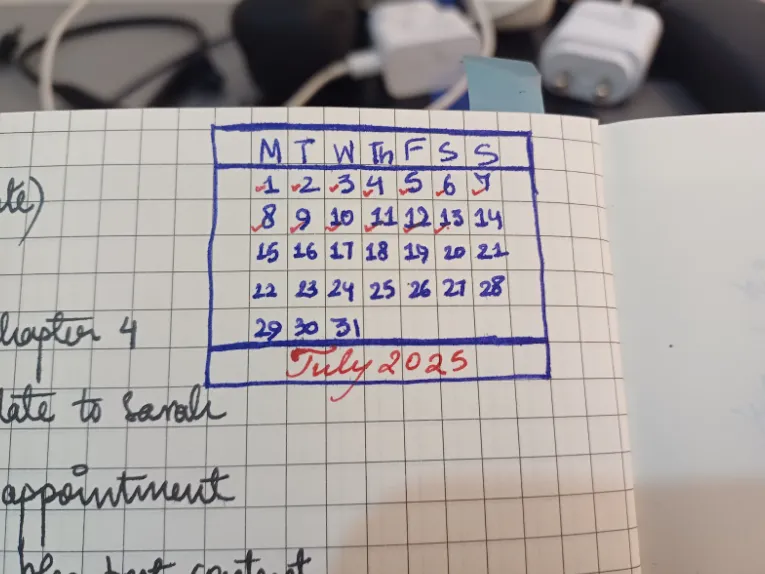
Circular or Creative Layouts
- Use a circle or other creative shapes for a unique calendar view.
- Divide the shape into sections for each day or week.
Tips for a Functional and Beautiful Calendar
- Use a pencil first: Sketch your layout lightly before inking to avoid mistakes. I see that I have now developed an unbeatable habit of drawing all the lines by hand. It’s easy but messy! So if you’d like perfect lines, sketch them with pencil first using a ruler.
- Keep lines straight: Use a ruler or straightedge for crisp, clean boxes.
- Customize box size: Adjust based on how much you write each day.
- Add a key: Use symbols or colors for events, tasks, and appointments. See how to make a key for a bullet journal.
- Leave space for notes: A sidebar or bottom section is handy for monthly goals or reflections.
- Decorate mindfully: Add doodles, washi tape, or themed colors, but keep the calendar readable.
Common Challenges and Solutions
| Challenge | Solution |
|---|---|
| Uneven boxes | Count grid spaces carefully, use a ruler, and sketch in pencil first. |
| Not enough space | Use a double-page spread or make boxes larger for busy months. |
| Smudging ink | Use quick-drying pens and let ink dry before erasing pencil marks. |
| Forgetting events | Add a color-coded key or highlight important dates. |
| Making mistakes | Cover with stickers, washi tape, or embrace imperfections. |
Decorating Your Calendar
- Headers: Use calligraphy or bold lettering for the month and days. If you want to learn how to write bullet journal calligraphy or how to draw bullet journal headers, practice here.
- Borders: Outline boxes with colored pens or add drop shadows for depth.
- Doodles: Add small illustrations that match the month’s theme (flowers for spring, leaves for fall).
- Stickers and Washi Tape: Use to highlight special days or add pops of color.
- Color Coding: Assign colors to categories (work, personal, birthdays) for quick reference.
Inspiration: Creative Calendar Ideas
- Traditional 2-page grid: Spacious and easy to read.
- Sidebar for goals or notes: Track monthly intentions or to-dos.
- Highlight weekends: Use a different color or larger boxes for weekends.
- Habit tracker integration: Add a row or column to track habits within the calendar.
- Minimalist style: Simple lines, monochrome palette, and plenty of white space for a clean look. See how to start a minimalist bullet journal.
- Themed spreads: Match your calendar to the season, holidays, or personal interests for extra motivation.
Frequently Asked Questions
Do I need to be good at drawing to make a calendar?
No! With a ruler and basic supplies, anyone can create a neat and functional calendar. Decorative elements are optional, so don’t worry if you’re wondering how to bullet journal when you’re not artistic.
What if I make a mistake?
Use correction tape, stickers, or washi tape to cover errors. Remember, your bullet journal is for you—imperfections add character.
How do I fit everything on one page?
Adjust box size, use abbreviations, or try a vertical list layout for a more compact calendar.
Can I use printables or stencils?
Absolutely. Printables can be pasted in, and stencils help with consistent boxes and designs. See how to use bullet journal printables.
More Ways to Use Your Bullet Journal
- How to write a bullet journal: Start with an index, future log, monthly log, and daily log.
- How to use bullet journal: Track tasks, events, notes, and goals.
- How to start a bullet journal for beginners: Begin simple, add features as you go.
- How to maintain a bullet journal: Update regularly, review your entries, and migrate tasks.
- How to decorate first page of project bullet journal: Use your favorite colors, stickers, or inspirational quotes.
- How to improve your handwriting bullet journalbullet journal: Practice regularly, use guides, and try different pens.
- How to write neat in a bullet journal: Slow down, use guidelines, and choose the right pen.
- How to write quotes in a bullet journal: Use calligraphy or hand lettering for emphasis.
- How to put your ideas in bullet journal: Dedicate a spread for brainstorming or mind maps.
- How to take meeting notes in bullet journal: Use bullets, headings, and action items for clarity.
- How to use bullet journal effectively: Review your logs, set priorities, and reflect on progress.
- How to use bullet journal for work, for project management, for weight loss, or for school: Customize layouts for your needs.
- How to bullet journal to achieve goals: Set monthly intentions, track progress, and celebrate achievements.
- How to add pages to bullet journal: Use washi tape or glue-ins for extra space.
- How to combine bullet planner with personal journal: Mix planning with journaling for a holistic approach.
- How to make a bullet journal index: Reserve the first few pages for an index and update as you add new spreads.
- How to set up a bullet journal for school: Create sections for assignments, schedules, and deadlines.
- How to start a simple bullet journal: Use basic layouts and minimal decoration.
- How to make a bullet journal in keynote: Design your layouts digitally and print or use on a tablet.
Final Thoughts
Drawing a calendar in your bullet journal is a blend of planning and creativity. Whether you prefer a minimalist grid or a vibrant, decorated spread, the process is flexible and rewarding. Start simple, experiment with layouts, and refine your approach as you discover what works best for you. Over time, your bullet journal calendars will become not just tools for organization, but also a reflection of your style and journey.
Happy journaling!

